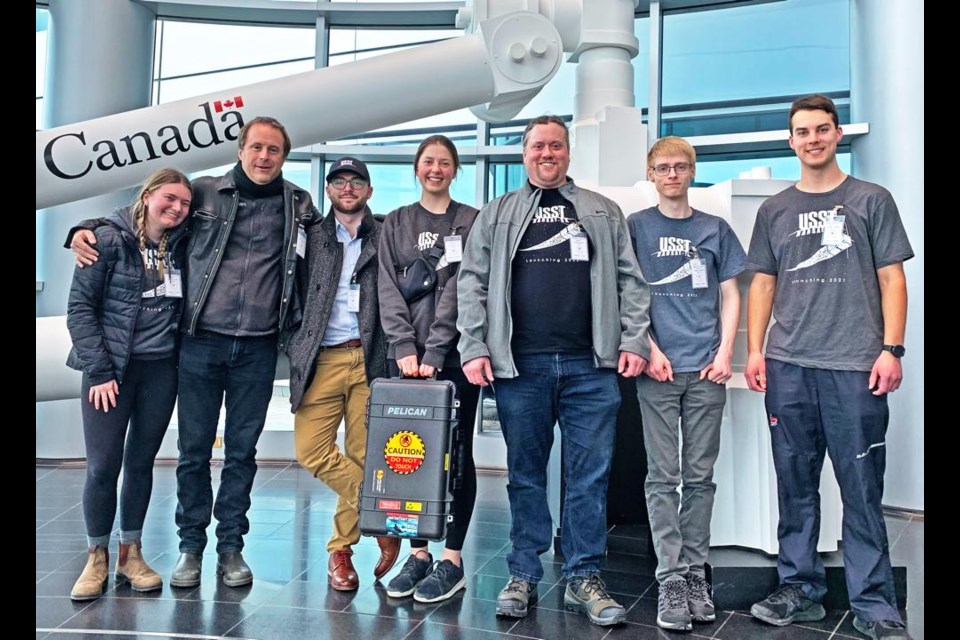WEYBURN – Saskatchewan’s first satellite, the RADSAT-SK CubeSat, is on its way to Florida for launch on June 1, and it will be deployed into orbit around Earth from the International Space Station (ISS) in July.
Weyburn engineering student Arliss Sidloski is a member of the University of Saskatchewan’s Space Team, which helped to put together the satellite, and she and the team members will be heading to Florida to see the launch of the satellite.
The RADSAT-SK CubeSat Project is a partnership between the Canadian Space Agency, the USask College of Engineering, Saskatchewan Polytechnic, and the USask Space Design Team. Arliss is in her second year as president of the USask Space Design Team, and she is one of the technical project managers for the cube satellite project.
The industry partners are Galaxia Mission Systems and Calian Advanced Technologies. This project also would not have been possible without the Primary Investigators (PI's), Dr. Sean Maw and Dr. Brian Berscheid, noted Arliss.
“Right now, our CubeSat is scheduled to be delivered to the ISS via SpaceX CRS-28, which is to launch from the Kennedy Space Center in Florida on June 1. The CubeSats are scheduled to be deployed from the ISS on July 10,” said Arliss.
“It is really mind-blowing that our team was able to achieve this,” she added. “As far as we can tell, the RADSAT-SK CubeSat will be the first satellite that has been designed, tested, and assembled in Saskatchewan that is actually going to be deployed. The team has put in countless hours and many long nights to get to this point, so it is so rewarding to finally be able to say that our CubeSat is finally going to space! We are 'over the moon' about that.”
She explained that once the satellite is launched from the space station, it will initially be in the same orbit. The cube satellite doesn’t have its own propulsion system, so it will last for about a year before Earth’s gravity draws it in, and the unit will eventually burn up in the atmosphere.
“Our team is in the process of commissioning our ground station, which is located on some nearby university land. We are grateful to the Department of Physics and Engineering Physics for their support with this. We will use the ground station to communicate with the satellite and collect telemetry from the payloads on it,” said Arliss.
At the end of March, members of the U of S team flew to the headquarters of the Canadian Space Agency in Montreal to deliver the CubeSat for integration.
“After our final tests were performed, the CubeSat was put into the Nanoracks CubeSat Deployer (NRCSD), which consists of specially machined then anodized aluminum panels and a spring,” Arliss explained, noting their CubeSat was put into the same deployer as a cube satellite from Western University. The deployer mechanism has been shipped to Florida to be part of the payload for a resupply flight to the space station.
“We are planning on booking a big Airbnb for us all to stay in. Needless to say, we are all super excited!” said Arliss of the team’s plans, noting they want to take an extra day or two for sightseeing in Florida, including taking a tour of the Kennedy Space Centre.
The following is the official statement about the payload and the purpose of the data to be collected by the satellite while in space:
“The RADSAT-SK CubeSat houses an experimental dosimeter board developed by USask’s Electrical and Computer Engineering professor, Dr. Li Chen, along with his team, and a fungal melanin coating that is purified from G.simplex for radiation shielding, as part of Dr. Ekaterina Dadachova’s team’s research.
“The dosimeter board includes a number of low-cost experimental MOSFETs (metal-oxide-semiconductor field-effect transistor), which demonstrate a linear relationship between output and total absorbed dose during ground testing, and a commercial RADFET (radiation-sensing field-effect transistor) used for calibration and comparison purposes. Some of the MOSFETs are covered with a melanin-containing coating, with increasing melanin content across samples, in order to test the feasibility of melanin as a cosmic radiation shielding method in space.”





